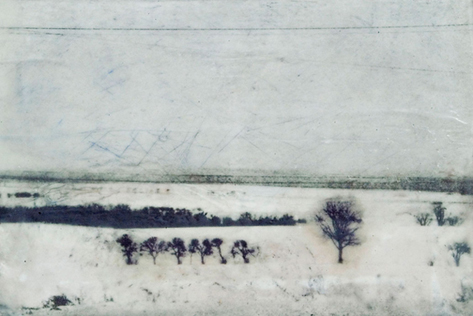

By: Jill Enfield
The encaustic process when used in photography refers to applying hot beeswax over a photographic image. This wax can be pigmented with color or remain white or creamy beige and it can give the image an intriguing surface and density.
In the world of alternative photography, anything old is new again. Sometimes, it seems that photographers who are interested in traditional processes get into a friendly contest on who is using the most authentic technique or who has the most spider webs on his classic, collectible lens.
If this is the contest, I can finally pull ahead! Encaustic painting or painting with wax was mentioned by Homer in 800 B.C. when he noted the waxed hulls of the painted warships sailing into Troy. Another example is the Fayum funeral masks of wax painted on thin wooden veneer. The masks are as vibrant as they were when painted in the first century. Take that, you wet collodion fans!

The basic material used in encaustic work is encaustic medium that is a combination of beeswax and Damar resin. A good source for the medium is R&F Paints (www.rfpaints.com) that can be thought of as the Mecca for encaustic painters. They also supply the oil pigments, equipment, other supplies and information you'll need to get started.
The simplest techniques require an electric cooking skillet with a temperature control, a paintbrush and a heat gun from your local paint store. Good ventilation is critical because at certain temperatures wax has the capacity to release harmful, carcinogenic compounds. The R&F Paint website has a thorough information sheet that you should review before you attempt the process.
What is a photoencaustic art piece? Essentially it's a 'sandwich' of a wooden base (artist panel or piece of birch plywood), a white base of paper or gesso attached to the wood, a photographic image and many layers of wax or encaustic medium. Each item that is added must be absorbent and is 'fused' to the whole by a brief blast of heat from the heat gun. The final piece must be joined together by the heat to prevent layers from separating and cracking.
A photographic image can be added to the piece by several methods. A darkroom printed alternative photography image can be used if it is printed on cotton rag or fabric (cyanotype, platinum, Vandyke, etc.). The image can be digitally printed onto the base paper (simple watercolor paper or 100% cotton rag). It can be printed onto thin, uncoated Japanese papers or transferred onto the wax from color copies or other ink/toner sources. Stay away from coated inkjet papers because they won't allow the wax penetrate the surface.
A photographic image combined with encaustic adds a third dimension of translucency and texture. The luscious wax surface begs to be touched and the expressive possibilities with color are endless. So if you are yearning for an approach to your photography that is highly creative and if you like the idea of working around a sweet honey smell, grab a heat gun and turn on the skillet. Photoencaustic techniques may be for you.
Alternative Process